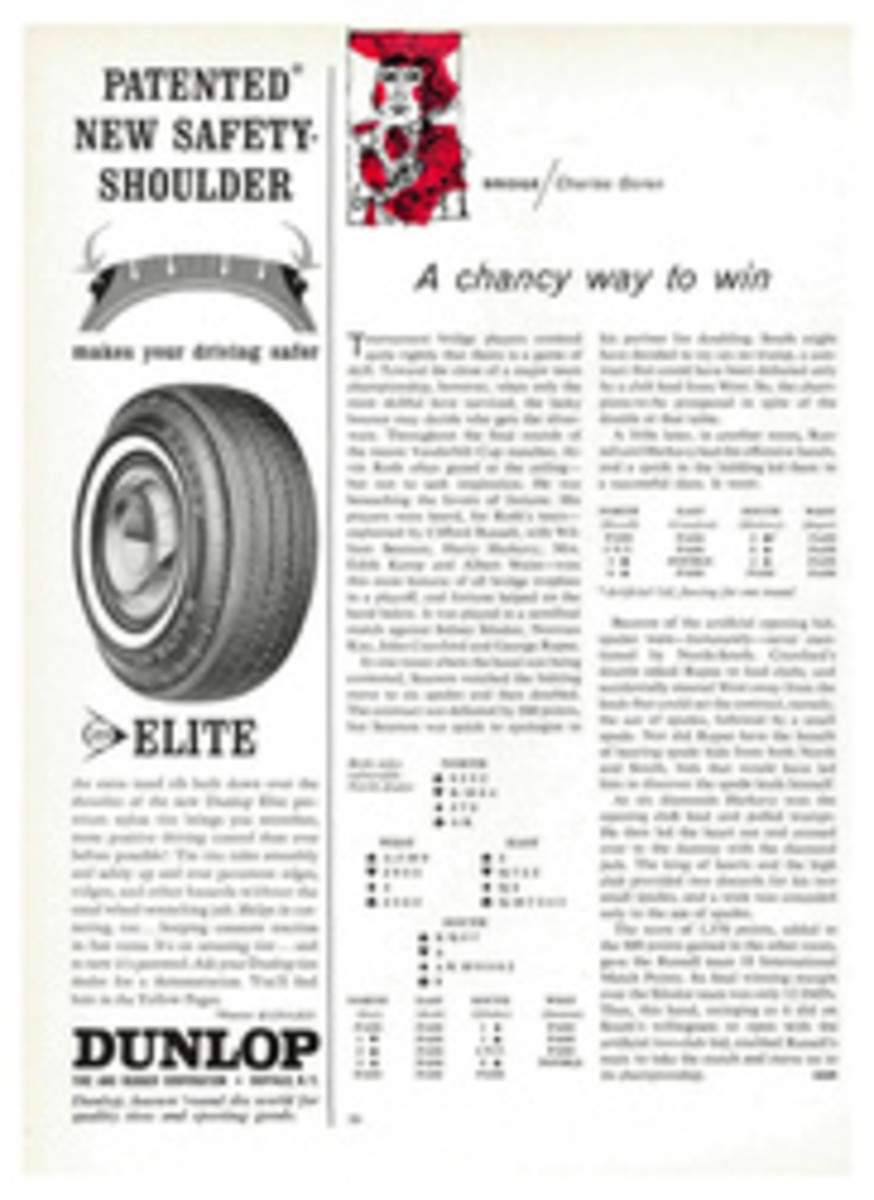
How to Make a Champion out of a 4-year-old
In one of those generalities dismal enough to be true we are often told that to become a champion in certain sports it is important to get off to an early start. The generalizers argue that as the twig is bent so is the bough inclined, and that the child is father to the man. But then, intoxicated by their wit, they push the idea past the point of good sense, and what they mean by an early start becomes fantastic, if not horrible.
Take figure skating. From the literature on the subject you'd think that the typical champion was able to skate before he or she could walk. Or swimming. Children are now taught to swim at about the same time they have mastered the scatter rug—or nonaquatic—crawl. Babies barely out of the diaper stage have balls tossed at them—in order to quicken their reactions. The day may come when a youngster is given a fiber-glass vaulting pole for his third birthday.
I bring up this subject of starting off the play-school—or pre-play-school—set in sports because I have had considerable experience, although I'll confess I have developed no champions. But I can still remember working out with my own youngsters, and since then I have tried to get various nieces and nephews off on the right foot. Friends—on what theory I have never been able to unravel—also come to me for advice on how to get Junior or Susie started.
For what it is worth, here are the results that painful experience has taught me to expect. I address this, of course, to fathers, because the head of the household is the logical candidate for instilling sports-mindedness in his offspring—even though he may have a mate who can make a monkey out of him at badminton or fancy diving.
BOXING. Every red-blooded father owes it to his boy to teach him the manly art of self-defense. The kid doesn't have to be developed into a heavyweight champion, but he should at least learn to beat up the girl across the street the next time she tries to snitch his cap. Here is what to do. Get down on your knees, thereby reducing your height advantage over Buster—who is, let us say, 4 years old. Assume a boxing stance, and instruct him to do likewise. Now give him a very gentle pat—I said very—on the chest.
Buster's lips will quiver momentarily, and he will then run to his mother, screaming, "Daddy hit me, and I didn't do nothing!" Straighten out your wife on what happened—and you might subsequently try to straighten out Buster on his grammar.
FOOTBALL. This modern razzle-dazzle forward passing is all very well, but the meat and potatoes of football still remain tackling and getting used to being tackled. Concentrate on this at the start. Instruct Buster to wrap his arms around your knees and push. When he does so, topple over with a crash, and exclaim, "Gee, you're strong!" He will bellow with glee.
Now wrap your arms around Buster's knees, and then—very gently push him over. He will run to his mother, screaming, "Daddy knocked me down, and I didn't..." (see BOXING, above). This would seem to indicate that Buster isn't cut out for contact sports. (Note: On rare occasions in the first situation, when Buster tackles you, instead of laughing he may run to his mother, screaming, "I hurted Daddy and I'm afraid he's going to die!" In that event he is very definitely not cut out for football—or anything more competitive than parcheesi.)
BASEBALL. This consists of three basic elements—throwing, batting and catching—which we shall take up in that order. Go to a field at a safe distance from your house, hand Buster the ball and direct him to throw it at you. He will do so promptly. If able to get up and stand erect without writhing, explain to him that a player doesn't throw the ball with all his might at a teammate unless the latter is a reasonable distance away—more than two steps, in any event.
Now hand the little fellow a bat, instruct him how to swing, and toss the ball to him. He will start his swing after the ball has passed five feet behind him. Now instruct him how to speed up his swing, and you'll find that he gradually increases his tempo until he completes it five feet before the ball gets to him. This proves how quickly kids adjust.
Take the bat away from him, put a glove on his hand and tell him how to hold out his hands to catch the ball. Make another gentle toss. Buster's hands will remain absolutely immobile—just where he originally held them—and the ball, which you failed to deliver accurately, will hit him in some part of the anatomy. His reaction will parallel that of the boxing experiment, the only difference being that his mother may not learn of it. This is what we meant when we said to conduct this experiment at a "safe" distance from the house.
TENNIS. This game should not be taught until your boy has mastered the elementaries of batting—which he should in two or three more sessions of baseball practice, provided they're not supervised by you. Go to a tennis court and take along two dozen tennis balls—old ones, unless your income is in six figures. Stroke the balls to Buster and you'll be absolutely amazed how his power and reactions have improved. He will hit the ball over a backstop on the average of once in every three tries.
The session is terminated when all balls have been lost in tall grass or underbrush—or discovered in terrain infested with ground hornets. On the way home you could try to explain once more that home runs in tennis don't count.
SWIMMING. One modern swimming theory holds that youngsters should just be heaved without any folderol into water over their heads, and be made to shift for themselves on the age-old principle of sink or swim. Try it out. If you happen to be wearing your best Madison Avenue suit at the time, instead of bathing trunks, this may give you an opportunity to ponder whether this theory holds water, or whether water holds Buster. And it could also give you a line on whether your suit is as unshrinkable as the makers claim.
BULLFIGHTING. To develop a matador—on second thought, it might be better to wait until your youngster is a little older before trying to get him off on the right foot in sports—18, perhaps.

